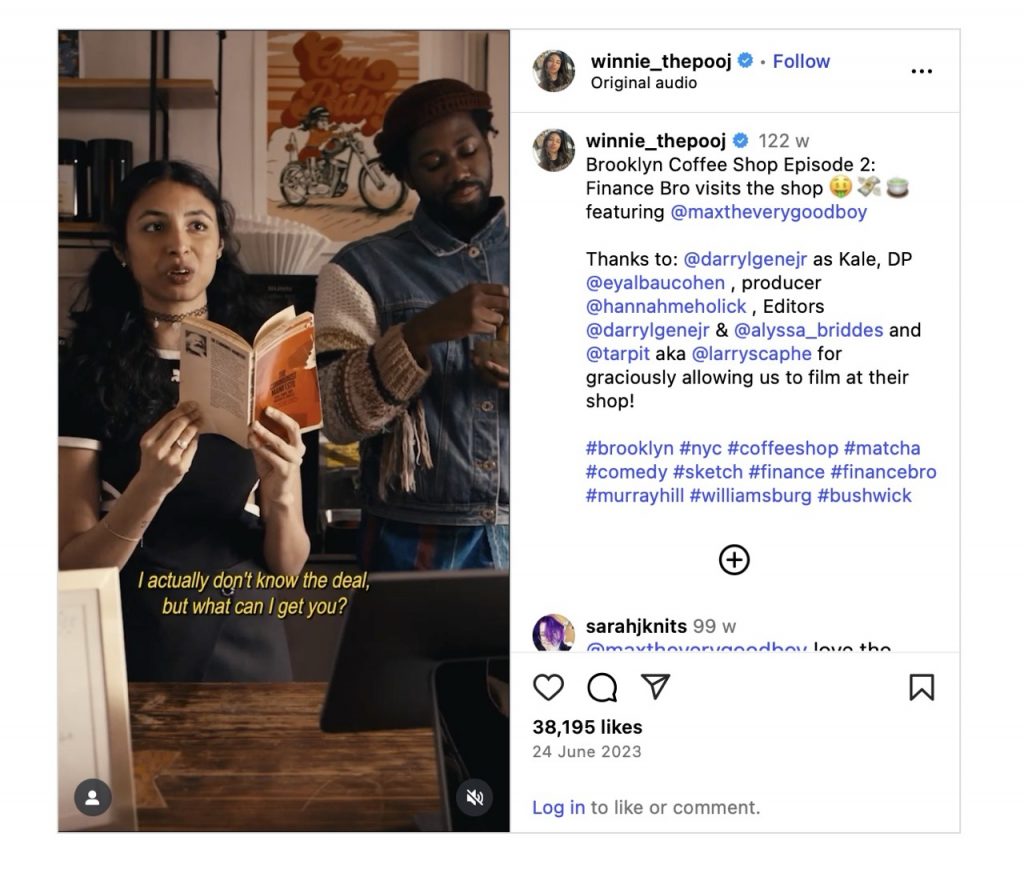Do you know the feeling – staring at your empty content calendar, thinking “what should we post next?”
Every social media manager, agency, and brand has been there. The truth is, the best social media content strategy isn’t about posting more, it’s about posting smarter – with purpose, consistency, and variety.
That’s where a clear framework helps. We’ve prepared a breakdown of the five main types of social media content you should be posting to keep your audience engaged, your message clear, and your workflow smooth. Check if you know them all 👇🏻
1. Educational and how-to content
Teach, don’t just tell
When followers scroll through their feeds, they’re not always looking to buy something (surprise, surprise 😏) – they’re also looking to learn something. Educational posts are the backbone of a good content strategy for social media because they deliver value first.
Think of how-to carousels, quick tips, mini-guides, or short videos that make your audience smarter in under 30 seconds. Brands that consistently share educational content see higher engagement and stronger trust. You become the go-to expert – not just another brand shouting into the void.
There are 6 main types of Educational posts:
| Type of educational post | Description | Example |
| Common mistake | Highlight frequent errors in your niche and how to avoid them | “Stop copying big creators, do this instead…” |
| Myth vs. Facts | Smack misconception with data and truth | “100 views hook vs. 1M hook” |
| Step-by-step tutorial | Break down process clearly | “How to plan a full month of content” |
| Framework / Formula / Acronym | Share a working method, or a repeatable system | “Here is your next week of content” |
| Quick tips / Hacks | Fast, bite-sized insights, that your followers can apply immediately | “5 tips on how to schedule your content fast” |
| Do & Don’t | Compare best practices & bad examples / execution | “Social media Do’s vs. Dont’s” |
How to create educational content
- Focus on specific, bite-sized topics: “How to write social captions that convert,” “3 tricks for tasty pancakes,” “How to plan a week of Reels in one go.”
- Use visuals – diagrams, screenshots, or mini-tutorial videos for YouTube, Reels or TikTok
- Keep your tone friendly and simple. No jargon, no fluff.
- End with a micro-CTA: “Try this tip in your next post!” or “Plan it faster with Kontentino.”
Once you’ve written a strong how-to post, repurpose it 👉🏻 turn it into a short video, a LinkedIn carousel, or a story highlight. Kontentino users often recycle one educational post into five different social media post types – all scheduled effortlessly through one calendar by using time savers.
2. Behind-the-scenes & brand-humanising content
Show the people behind the brand #storytelling
Social media isn’t just about logos and products – it’s about people. Behind-the-scenes (BTS) content lets your followers peek into your world. Whether it’s your creative process, a day in the life of your team, or the story behind a product, this type of post helps you connect on a human level.
BTS content performs especially well on Instagram Stories, Reels, and LinkedIn. Authenticity and relatability outperform polished perfection – people prefer to see real teams doing real work.
Why you should start posting BTS content
- Builds emotional connection. Followers see the humans they can relate to.
- Boosts engagement. Authentic moments get more comments and reactions.
- Supports employer branding. A strong internal culture attracts both clients and talent.
How to create it
- Capture real moments: brainstorming sessions, coffee breaks, or bloopers.
- Highlight your team’s wins – new features, launches, or milestones.
- Share your company rituals or values in visual snippets.
- Keep captions conversational: “We’re testing something exciting today 👀 Any guesses?”
💡 Do you like watching those behind-the-scenes from movies, where they show you how film was created? I personally LOVE IT! So why don’t do it for your brand? It shows that while AI can make anything faster, your business / creativity is still powered by people.
3. User-generated content & social proof
Let your fans tell the story
You can shout about how great your product is – or let your customers do it for you. User-generated content (UGC) is one of the most trusted social media content types because it’s real, authentic, and relatable. Research by Nielsen shows that 92 % of people trust recommendations from peers over brand advertising. That’s the magic of UGC – it’s like proof, not promotion.
How to create it
- Encourage your customers to tag you or use a branded hashtag.
- Repost their stories, testimonials, or photos (always ask permission).
- Add your voice in the caption: explain why you love this story.
- Combine UGC with campaigns: “Tag us in your next get-ready-with-me to get featured!”
Feature both clients and creators – it broadens your reach.
4. Short-form video series content
Turn consistency into a content strategy
Short-form video isn’t new – but how you structure it can make all the difference. That’s where series content comes in. Think of it as your own mini-show on social media: same format, new topic each time. It’s what’s currently popping off on platforms like Instagram and TikTok.
Instead of random one-off Reels, you build anticipation with a recurring theme – whether it’s “Monday Marketing Tips”, “30-second Content Ideas”, or “Behind the Brand”. The key? Repetition. Audiences love predictability wrapped in creativity.
As a perfect example of it is Brooklyn Coffee Shop, that created a vertical sitcom set in a real coffee shop in Brooklyn, New York. Created by Pooja Tripathi, it’s a sharp, satirical series that turns everyday internet subcultures into quick, hyperreal vignettes. Each episode features new creator cameos, giving the show fresh energy and reach every week, while the coffee shop itself becomes part of the brand story. With clever collaboration, tight production, and consistent posting, the creators are quietly building a digital-first brand that proves you don’t need a TV budget – just a smart idea and structure.

How to do it right
- Pick a recurring format. Educational bites, storytelling snippets, or weekly challenges.
- Keep the setup identical. Same hook, structure, or caption style – that’s what builds recognition.
- Plan in batches. Film 3-5 episodes at once, then schedule them using your Kontentino calendar to maintain rhythm.
- Hook fast. Start strong (first 3 seconds) with something like: “Oh my god, guess what? …..” — it humanizes and stops the scroll.
- Use templates for virality. When one video performs exceptionally well, double down – recreate it with small tweaks (topic, tone, or visuals).
Examples of video series you can create
- 🎥 “Ask me anything mondays” – answer 3 common questions about your niche.
- 💡 “My marketing tips” – 20-second tips in the same on-screen style each week.
- 👩💻 “My workflow wednesdays” – show how you create your product.
- ⭐ “Try this trend” – weekly trend breakdowns and how brands can use them.
Your short-form series doesn’t need fancy production it just needs clarity and consistency.
When done right, series content turns scattered short videos into a recognizable, binge-worthy format – the kind that builds loyal followers and keeps your feed looking cohesive without extra effort.
5. Promotional & offer-driven content (in the right dose)
Sell… but smartly!
Every brand needs to promote. That’s business. But it’s a fine line: too much promotion turns followers off, too little and you miss conversions. The secret? Balance.
A good rule of thumb: the 80/20 ratio – 80 % of your posts should inform / entertain / inspire and 20 % can directly promote. Promotional posts include new launches, features, case studies, discounts, or partnerships – but framed around value, not just sales.
How to create it
- Lead with benefits, not features: “Save 41 % more time with X” hits harder than “New update available.”
- Use visuals: before/after examples, metrics, testimonials.
- Keep copy short and bold, add a strong CTA.
- Test post types – carousels, videos, countdown stories – and measure what converts best.
- Use analytics to schedule promotions when engagement peaks.
Tie promotions to storytelling, and don’t forget, center your target audience’s needs first. Instead of “Buy now”, try “Here’s how our X product saves 5 hours every week – and it’s free to try.”
That’s a value-driven story and a soft conversion.
Want to combine all five content types? Here is template 👇🏻
You’ve got your five pillars. Now what? Time to build a simple, repeatable weekly / monthly content strategy for social media that keeps you consistent and balanced.
Here’s a weekly mix you can steal:
| Day | Content Type | Example |
|---|---|---|
| Monday | Educational | “3 tips to boost engagement this week” |
| Tuesday | Behind-the-Scenes | “How our team planned a campaign in 1 hour” |
| Wednesday | Video | “Try this caption trick” |
| Thursday | UGC | “Shout-out: agency X just hit 1 M impressions!” |
| Friday | Promotional | “New feature: LinkedIn profile mentions in posts 🎉” |
| Weekend | Flexible | Polls, memes, or quick engagement boosts |
This structure keeps your feed fresh and strategic – every post has a role.
🤫 Wanna know a secret? Those ideas were created by Kontentino AI in Brand Hub for Kontentino social media.
The hardest part about content creation isn’t creativity – it’s consistency. But when you have a clear system, a balanced mix, and the right tools, you can finally stop guessing what to post on social media and start focusing on why you’re posting it.
So next time your content calendar looks empty, remember:
- Educational content builds trust.
- Behind-the-scenes content humanises your brand.
- User-generated content validates your value.
- Short-form video series capture attention.
- Promotional content converts followers into customers.
Plan these five pillars, batch them, schedule them, and watch your engagement grow – while saving hours every week. Great social media strategy isn’t about doing more – it’s about doing it smarter 💡


